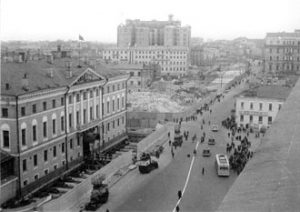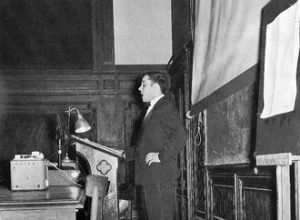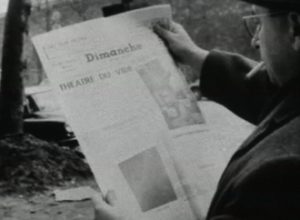
Our knowledge of Russia and the USSR is no longer in focus. That is the conclusion delivered here by three researchers who offer us a historiographical overview of painting, film, architecture, and urban planning. In their company, we exit a history centered around the decryption of ideological messages effectively imposed by the state apparatus. It is henceforth a question of artistic practices, commissions, markets, sales and resales, distribution, ways of exhibiting works, audiences, and artworks that avoid the model of propagandistic rhetoric out of a concern, in particular, for economic profitability. This economic question thus weighs heavily on everything, including fields in which this dimension had been left out under the pretext that capitalism had officially been banished.
Laurence Bertrand Dorléac
For an Economic History of Soviet Cinema
Valérie Pozner
Starting in the 1980s, a renewed outlook on the general history of cinema has helped to alter the kinds of questions that are raised about Soviet cinema, which have long been limited to a decryption of the “ideological message” or to the career of a few “major auteurs.” True, in Russia itself this historiographical revival has been of relatively little consequence, and the opening up of the archives has mainly fostered a greater knowledge of directors and their careers, notably as regards their problems with the censors.[ref] A broad overview of these works is provided by the Muscovite review Kinovedcheskie zapiski which, since its inception in 1988, has devoted a very large number of articles to this question of film censorship. English-language summaries of each of the four annual installments are available on the review’s website: http://www.kinozapiski.ru.[/ref] Numerous films (some from the 1910s and others “put on the shelf” between the 1930s and the 1980s) have been rediscovered, and progress has been made in publishing theoretical texts written by filmmakers (Sergei Yutkevich, Lev Kuleshov, Dziga Vertov) or unexpurgated versions of memoirs (Sergei Eisenstein’s, Mikhail Romm’s). Furthermore, the discovery of some documents showing Stalin’s direct involvement in controlling and censoring films, documents that are quite gripping in themselves, has focused the attention of researchers,[ref]See, in particular, Grigorij Mariamov, Kremlevskij cenzor [The censor of the Kremlin] (Moscow: Kinocentr, 1992) and Kremlevskij kinoteatr [The Kremlin movie theater]: 1928-1953 Dokumenty (Moscow: Rossijskaja Politicheskaja Enciklopedija, 2005).[\ref] thereby shunting aside entire chapters concerning the operation of the Soviet film industry. Now, the question of censorship should by itself have logically led researchers to pose some questions about film distribution: If such and such a film was banned, what then did the filmgoer see in the movie theater? How did he gain access? How many times did he attend shows during each period? Who decided the number of copies that would be printed? Can one, in the case of the Soviet Union, speak of the commercial success of this or that film, or of a “box office”? What consequences did that have for the director, for the studio?[ref]True, these questions had been raised by several sociologists as concerns the last decades of the Soviet period, beginning in the 1960s and 1970s. See, in particular, the works of Daniil Dondurej, whose numerous articles are available in Russian on the internet. Nevertheless, to our knowledge no targeted study of distribution patterns has been conducted for the prior period. This offers a striking contrast to the present period, for which studies and even specialized reviews devoted to the topic of distribution are legion.[/ref]
Now, to take up these investigations again, starting not from the most eminent of filmgoers who was shut up in his Kremlin projection room but from the neighborhood movie theater, leads one to revise a whole series of assumptions. Furthermore, the emergence of new corpuses of films during the 1990s has led one to pose some new questions. Thus, the projection of films produced by Mezhrabpom–a semi-private studio, dependent on the Comintern, that was active between 1924 and 1936–has revealed the importance of a commercial sort of production that harbored no great ideological ambitions and that was even devoid of any “political message” (historical costume films, melodramas, comedies, etc.). The study of specialized press organs during those same years has similarly revealed the Soviet audience’s infatuation with American film stars, whose screen presence is confirmed by studies on programming.[ref]Denise J. Youngblood’s classic work on commercial film production in the 1920s, Movies for the Masses: Popular Cinema and Soviet Society in the 1920s (Cambridge and New York: Cambridge University Press, 1992) is to be examined here.[/ref] Did such production compete with Soviet production? If yes, until what date? Under what conditions were those films imported and why? And the answer is simple: to rake in receipts. Which leads us to ask some questions that employ the well-known terms of today’s culture industries, namely: What, year by year, was the market share of domestic production?
The idea of Soviet cinema being wholly preoccupied, throughout its history (that is to say, from 1919, the date it was nationalized, until 1991), solely by the objectives of political education and propaganda, educational films alternating with entertainment films, the latter aimed at creating a virtual reality in order to divert the Soviet filmgoer from everyday forms of violence, and regardless of any considerations about return on investment, proves in large part to be false. The very idea that cinema ought to be a profitable branch had in reality been imposed on Soviet cinema from its beginnings.
Here we shall set down a few markers for the drafting of this history.
Distributing in Order to Produce: One and the Same Model for the 1910s and the 1920s
The first Russian film producers were above all distributors of European-produced films. They gradually found their bearings by freeing themselves from their initial bosses, who headed the Russian branches of firms like Pathé, Éclair, and Cines (which themselves had been established on Russian imperial territory, chiefly in Moscow, during the early years of the twentieth century). Little by little, starting in 1909-1910 these distributors opened studios of their own and hired cameramen. Their stature grew very quickly, as did their numbers, during the 1910s. On the eve of the October Revolution, Russian cinema was a prosperous branch of industry that owed its robust development to the blockade that had been imposed on the country at the beginning of World War I. With French, Italian, German, Swedish, and American films (which had been highly present on Russian screens during the previous years) no longer being imported, Russian cinema underwent a boom starting in 1914.[ref]The economic issues facing Russian cinema in the 1910s were tackled in a old work that has recently been reissued: Semen Ginzburg, Kinematografija dorevoljucionnoj Rossii [Russian cinema before the Revolution] (Moscow: Agraf, 2007).[/ref] Yet this boom was of very brief duration: the end of the War led to restrictions on equipment and then shortages of film stock (Russia would import movie cameras, film projectors, and film stock until the end of the 1930s). These shortages turned drastic, and the general collapse of the country that began in 1917-1918 led the few studios still active at the time to withdraw to the southern portions of the country not yet occupied by the Reds (Odessa, then Yalta). Then came, in 1920, the emigration of most producers and their film crews (directors, actors, cameramen, set designers). Russian cinema remained at a standstill until 1922. In the Fall of 1922, film exhibitors, taking advantage of the liberalizing business measures adopted within the framework of the New Economic Policy (NEP) in 1921, reopened their movie houses–though not all of them, it goes without saying, and only quite gradually. For, with the end of the war, film stocks were low and copies were in a sorry state. It was at that time that the first joint-stock companies created under the NEP turned toward the importation of foreign films. These were often films that had already made a profit in most European countries, so that they could be sold at low rates. The receipts these films brought in were going to relaunch film production. The mechanism was simple and would give birth to the first Soviet studios. Those studios were initially, as in the 1910s, distributors and, more precisely, importers, and for a long time they sought to remain so. Despite complaints from the censors[ref]Part of the censorship files for this period have been preserved. A study of them shows that, despite the cuts and despite demands to change title cards, a large portion of imported films were distributed.[/ref], production had to be restarted, and given the impoverished condition of the Bolshevik State, no other option was available. The People’s Commissariat for Industry and Commerce gave its approval: 1923 was a record year for imports. Soviet production got truly off the ground only in 1924. The connection is obvious, and it demonstrates that one cannot disregard economic questions if one wants to retrace the first steps of Soviet cinema.
We shall not linger here in detail over the growth of various studios during the 1920s, the bankruptcies some of them (Kino-Moskva, Proletkino, etc.) experienced, or the successes of others (VUFKU in the Ukraine, Goskinprom in Georgia, Mezhrabpom-Rus in Russia). At the end of the NEP period, the policy of the main studio, Sovkino, was challenged for its “commercial excesses”: according to critics,[ref]These critics came from among the ranks of “left” filmmakers organized within the LEF (Left Front of the Arts) as much as from among political officials (from the Central Committee, the Office of Political Education within the People’s Commissariat for Education, and censorship organs), or from the unions.[/ref] the studio gave preference to ideologically not very satisfying big productions, held political and educational films in contempt, and distributed especially German and American films wherever they could. Sovkino became in fact one of the main studios and, moreover, starting in 1925 it held the monopoly on film distribution on Russian territory (the Russian Soviet Federated Socialist Republic, or RSFSR). Now, the situation was not simple: the studios in the other republics, particularly in the Ukraine and in Georgia, imported films and distributed them on their own territories, thus competing with Sovkino. The system for turning over receipts was complex, and the legislation was frequently circumvented. Disputes became more and more frequent and were sent as far back up as the Central Committee. While this aspect of the history of cinema in the republics is generally unknown, it occupied, in the late 1920s, a key place.
In Search of a Viable Industrial Model
For lack of time, we shall concentrate here on the territory of the RSFSR. The criticisms Sovkino encountered ought not to mask the reality of the situation. Despite its efforts, Sovkino did not succeed in balancing its books, and that was the case for several reasons. It swallowed up some bodies that were themselves in debt (such as Proletkino, Sevzapkino, and Gosvoyenkino, the studio attached to the Red Army). Moreover, exportation of Soviet films was stagnating. Finally, and, especially, the network did not succeed in achieving expansion. Indeed, the exhibition of films did not depend on Sovkino itself but was entrusted, instead, to the provincial educational network, to private cinema owners, to local administrations, to unions, and to cooperatives. This network was running considerable deficits. Money therefore was not coming into its coffers. And when it did come in, it did not come back into the Sovkino circuit to float its production funds. The deficit increased year after year. The situation would be reexamined subsequent to the March 1928 Party Conference on film, during which Sovkino, just like Mezhrabpom, was under fire from critics. It was during this conference that the “Cinema for Millions” slogan was launched. Until now, historians have emphasized the Party’s takeover of the cinematographic sector and the decision to privilege cinema devoted to political education over the commercial production of fictional stories for both imports and Soviet-made films.[ref]See, in particular, Richard Taylor and Ian Christie, ed., Inside the Film Factory: New Approaches to Russian and Soviet Cinema (London and New York: Routledge, 1991) and Peter Kenez, Cinema and Soviet Society: From the Revolution to the Death of Stalin (London: Tauris, 2001).[/ref]” And in a sense, this reading is correct. However, we shall insist here on another reading of the documents that were produced on this occasion: “Cinema for Millions” also signified an increase in the number of movie theaters, the number of films, the number of copies, their quality, and their life span. But above all, this also had to be a profitable form of filmmaking. “For Millions,” literally–that is to say, for millions of rubles! Film had to replace vodka not only in the workers’ leisure time, as Trotsky had recommended in 1923, but as a source of revenue for the State. Finally, it was during this conference that an awareness of the industrial character of cinema emerged: the hitherto prevailing small-scale, artisanal model, with a multitude of studios attached to the Commissariat for Education that were entirely dependent on foreign sources for film stock and equipment, had had its day. The development of cinema necessitated the development of its “technological base.” While the Hollywood model was not mentioned directly, it really was that model that was taking shape beneath the surface: connecting the exhibition of films to their production allowed one to reinvest the receipts in production and in the development of the distribution network. But the conference made no decision about which kind of structure would most likely allow development of this sector so as to make it autonomous and competitive. Finally, after lengthy discussions within many commissions and authorities, the model chosen in 1930 was that of a super-concentration at the level of the Soviet Union as a whole–which is in no way surprising within the context of the “Great Turn.” Without entering into all the expository developments these issues would require, we shall point out here that the years that followed were ones of major crisis: lack of investments in this industrial sector did not allow rapid growth of the “technological base,” while the halt to the importation of films, film stock, and equipment brought Soviet cinema to its knees through till 1933: there was a drastic drop in the number of films produced, a quite tardy arrival for talkies, a very slight number of copies distributed, closings of movie theaters, and a catastrophic drop in technology and equipment standards. This history has yet to be written, but it merits close examination in light of documentation coming not from the archives of directors but from the archives of studios and from those of the various authorities that were in charge of cinema: the Supreme Economic Council, the Gosplan, the People’s Commissariat for Finance, and the People’s Commissariat for Foreign Trade.
A Paradoxical Return to the Prior Model: From the War to the Late 1950s
The situation gradually returned to normal during the second half of the Thirties. But a major halt was occasioned by the War, with some studios ending up in the occupied zone (Kiev, Yalta, Odessa) or having to be evacuated (from Moscow and Leningrad). Their redeployment in Central Asia and in Siberia, and then their return, was accompanied by heavy loses that were compensated for only partially by the equipment later seized mainly in Germany. Now, in the aftermath of the War, the authorities again set goals for returns on investment. Historians have not yet sufficiently emphasized this aspect and have shown an interest up till now above all in Party measures designed to take back over the cultural sector, measures which, in the case of cinema, were expressed by a drastic effort to gain control over the “ideological quality” of films. The campaign launched in the Fall of 1946 culminated in a major production crisis: unending revisions of scripts, increasingly zealous checks on films, the increased length of production schedules, and a spike in the number of banned films. [ref]Natacha Laurent, L’Oeil du Kremlin (Toulouse: Privat, 2004).[/ref] Now, Soviet cinema was being expected at the same time to have a return on investment. It was under those conditions that it was decided in 1947 to put on the market some much-talked-about “trophy films” (spoils of war taken on the territories occupied by the Soviets: Poland, the Baltic States, Germany). When one emphasizes the Stalinist films of the “personality cult” period–such as Mikheil Chiaureli’s 1946 film The Vow or his 1949 film The Fall of Berlin–one generally forgets what was really going on in movie theaters and with programming: alongside the Soviet films of the Cold War period, the films being shown on screens were American productions from the 1930s and even German films produced under the Third Reich. From all these spoils of war, which included several thousand titles, genre films with minimal political content were selected for showing: musical comedies, adventure films with pirates, melodramas, and so. Of course, they were slightly re-cut. Yet these films were a very far cry from answering the demands then being made on Soviet films. Such decisions may be explained by economic necessities.[ref]See, on this topic, my contribution to the volume edited by Jean-Pierre Bertin-Maghit: “Les limites de la propagande soviétique dans l’après-guerre,” Une histoire mondiale des cinémas de propagande (Paris: Nouveau Monde, 2008), pp. 561-79.[/ref]
Writing the history of Soviet cinema today requires that one take this dimension into account. Restricting oneself to a few films or to a few great directors, however famous they might be, condemns us to a highly truncated view of a process that is both complex and fascinating.
bibliographie
Daniil Dodurej, «Kinoprokat : zhemchuzhina industrii razvlechenija [la Distribution – perle de l’industrie du divertissement], Otechestvennye zapiski, n°4, 2005.
Semen Ginzburg, Kinematografija dorevoljucionnoj Rossii[le Cinéma russe avant la Révolution], Moscou, Agraf, 2007.
Peter Kenez, Cinema and Soviet Society. From the Revolution to the Death of Stalin, Tauris, 2001.
Kremlevskij kinoteatr [la Salle du Kremlin]. 1928-1953. Dokumenty, Moscou, Rossijskaja Politicheskaja Enciklopedija, 2005.
Natacha Laurent, L’Œil du Kremlin, Toulouse, Privat, 2004.
Grigorij Mariamov, Kremlevskij cenzor [le Censeur du Kremlin], Moscou, Kinocentr, 1992.
Valérie Pozner, « les Limites de la propagande soviétique dans l’après-guerre », J.P. Bertin-Maghit (dir.), Une histoire mondiale des cinémas de propagande, Paris, Nouveau Monde, 2008, p. 561-579.
Richard Taylor and Ian Christie (dir.), Inside the Film Factory: New Approaches to Russian and Soviet Cinema, London-New-York, Routledge, 1991.
Denise Youngblood, Movies for the masses. Popular cinema and soviet society in the 1920’s, Cambrige University Press, 1992.
Valérie Pozner est chercheur au CNRS (Arias – atelier de recherche sur l’intermédialité et les arts du spectacle, CNRS/ENS/P.III), spécialiste de l’histoire du cinéma russe et soviétique. Elle est l’auteur de nombreux travaux sur les années vingt (thèse sur le fondateur du formalisme russe Viktor Chklovski, scénariste, critique et théoricien du cinéma) et de traductions de textes théoriques (Lev Kouléchov, Sergueï Eisenstein, les formalistes russes et le cinéma, etc.). En dehors des questions de théorie du film, elle a abordé dans divers travaux la question du scénario, de l’acteur, du film historique, de l’adaptation littéraire, du reflet de la société de la NEP dans le cinéma des années vingt.
Elle mène également des recherches sur l’histoire institutionnelle, notamment dans le cadre d’une monographie en cours sur le passage au cinéma parlant en URSS (1927-1935). Ce travail sur le son a été précédé de travaux sur l’accompagnement oral des projections cinématographiques muettes depuis les années 1910 jusque dans les années 1930 et sur le rapport image/écrit (intertitres).
L’an dernier, elle a conduit un important projet sur l’image des Juifs dans le cinéma russe des années dix aux années soixante (rétrospective, organisation d’un colloque, édition d’un catalogue avec documents d’archives, l’ouvrage doit paraître fin 2010).




